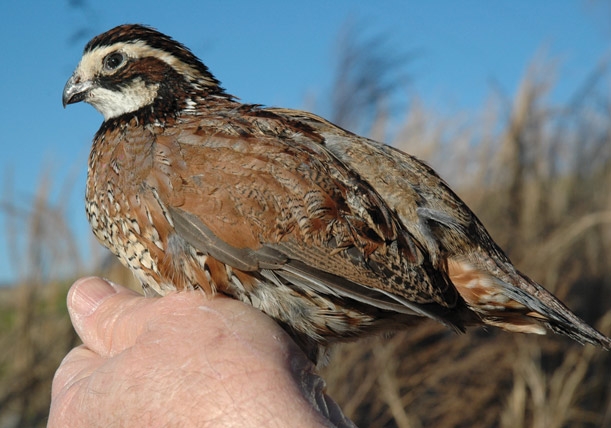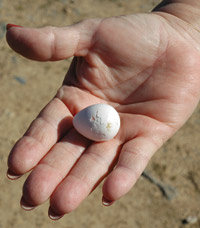
Photos by Sheryl Smith-Rodgers
Firmly but gently, Marvin Vick cups a Northern bobwhite quail in one hand and with his other splays out the bird’s delicate wing feathers. Below him on the ground, three more bobwhites huddle together in a wire pen. The rich copper, bronze and black hues of their markings blend into the dry grass that surrounds them.
"See the curved tips of his wing feathers?" Marvin asks, using his thumb and forefinger to hold several in place. "His tail feathers are curved, too. That’s what makes a good flying bird."
Marvin knows, because he has hunted the wild birds all of his life. What’s more, he and his wife, Faye, have raised them commercially on their farm near Oneonta, Ala., since 1997. From the initial 3,000 chicks the couple bought and raised that first year, their business — Vick’s Gamebirds LLC — has steadily grown to an annual production of 350,000 flight-ready quail, which they largely market to hunting preserves in the region.
Demand is so strong that the Vicks could sell even more birds. "If we’d had them this season, we could have sold another 100,000 birds," Marvin adds.
The Vicks also raise and sell ring-necked pheasants and host bird hunts on their land.
“I don’t know how Mr. Vick does it, but his birds are the closest thing to wild birds I’ve ever seen.” – Danny White
From Milking Cows to Raising Quail
As newlyweds in 1963, the Vicks lived on a dairy farm where Marvin worked. The next year, the couple moved down the highway, and Marvin and his brother started their own dairy farm. In 1985, the Vicks bought the dairy farm where they’d once lived and built a brick home that overlooks a wooded valley.
"I’d been in the dairy business all my life," Marvin says. "In 1995, we sold our milk cows. We weren’t making any money. That’s about the time when we started playing with quail and then — BOOM!" Marvin laughs.
Faye, nodding in agreement, smiles and says, "We had a friend who asked us, ‘Why don’t you raise some quail to hunt on your land?’ We decided we’d try it so we bought 3,000 day-old chicks. Marvin was so afraid we wouldn’t be able to sell them."

Faye and Marvin Vick
Succeeding By Trial and Error
That first year, the Vicks kept the young birds in an existing barn on their farm. "The people who sold us the chicks were very helpful in helping us get started," Marvin recalls. "After that, it was trial and error." For one thing, the couple quickly realized the barn wasn’t suitable for housing and raising bobwhites.
"Little quail are suicidal," Marvin says. "Any way they can kill themselves, they will. Nope, they’re not smart at all!"
"And they’re more sensitive to heat than cold," Faye adds. "With our 90- and 100-degree days during the summer, it’s hard to keep them cool enough. The barn had no insulation and not enough ventilation."
To remedy that problem the next year, the Vicks bought and renovated poultry houses located on other farms in the area. In 2004, Ben Gore, Albertville branch manager and senior vice president of the Federal Land Bank Association of North Alabama, helped the couple obtain a Land Bank loan to build three quail houses on their farm. To date, the Vicks own 14 houses, all of which are cross-ventilated and properly equipped for raising quail.
"I’m really amazed at how their business has grown," Gore says. "They’re hardworking people who’ve been great customers."
Producing Top-Class Gamebirds
In the field, hunters want quail that startle easily and flush together into the air as a covey. "If you have a bird that doesn’t fly, then you won’t sell birds," Vick says matter-of-factly.
To keep them skittish and wild, quail chicks — which easily imprint to humans — must be raised in seclusion and kept in minimal light to reduce their activity. Because the species is also highly susceptible to diseases and infections, facilities must be kept as clean as possible. Translated, it all means one thing: The business of raising Northern bobwhites requires hands-on, specialized care — and plenty of it.
80,000 Eggs a Week
Quail production starts in June when the Vicks purchase day-old chicks from nearby River View Quail Hatchery owned by their son, Seth. On a weekly basis, Seth — also a member of the Land Bank Association — collects 80,000 quail eggs and hatches some 60,000 chicks. (He tends the family’s 12 outdoor pens of ring-necked pheasants, too.)

The Vicks’ son, Seth, owns a hatchery that hatches some 60,000 quail eggs per week.
Soon after hatching, the tiny chicks are released from boxes onto the ground in the quail houses, which are darkened by black plastic sheets hung curtain-style across screened windows. Brooders hung from rafters give warmth during development while nipple drinkers provide water. To reduce bacterial and viral infections, Marvin designed an enclosed feeding system, which keeps the birds’ droppings out of troughs.
"We keep a schedule at each house, so we always know what needs to be done and how old the birds are," Faye says. Regular duties include washing out water lines, raising curtains and adjusting temperatures. Two full-time employees assist the Vicks in their daily work.
Production cycles continue through the end of October. Quail mature by 16 weeks of age and are ready for market two weeks later. "They’re a good flying bird by then," Marvin says. "At 20 weeks of age, they’re the best flying bird."
Supplying Quails Throughout the Southwest
The Vicks sell quail to 16 hunting preserves in Alabama, Georgia, Mississippi and Tennessee. One is Circle W Hunting Preserve and Sporting Clays, located in northeastern Alabama. For the past eight years, owner Danny White has bought quail from Vick’s Gamebirds.
"Their birds are the best in America," he says. "There are no birds — and I’ve been all over the Southeast — that compare to theirs. I don’t know how Mr. Vick does it, but his birds are the closest thing to wild birds I’ve ever seen. I’ve built my reputation on Mr. Vick’s birds and my dogs.
"Those Vicks — they know how to raise birds!"
-Sheryl Smith-Rodgers
Supporting a Tradition
In the South, quail hunting was once revered as a tradition to be passed from generation to generation. Quail populations peaked into the 1960s, but gradually the birds’ numbers began to decrease.
Over the years, loss of suitable habitat has primarily led to the birds’ decline. In order to reproduce, bobwhites require grasslands for nesting and insects, crops for food and cover, brambles for fruit and cover, and bare ground for dusting themselves.
Fewer farms, increasing urban sprawl, and the use of pesticides and herbicides have contributed to the decline in wild quail, biologists say. Because the sport of quail-hunting remains popular, owners of many plantation and hunting preserves in the South purchase pen-raised quail, which has become a viable business for people like Marvin and Faye Vick in Alabama.
"All our birds are spoken for and sold a year in advance," Faye says